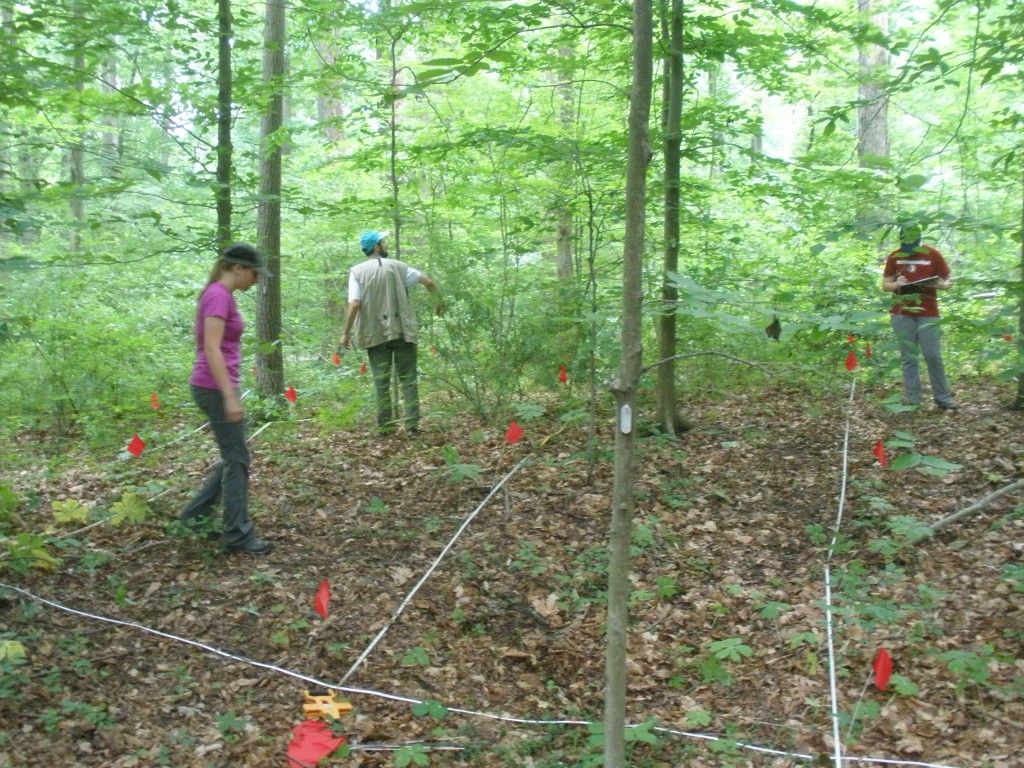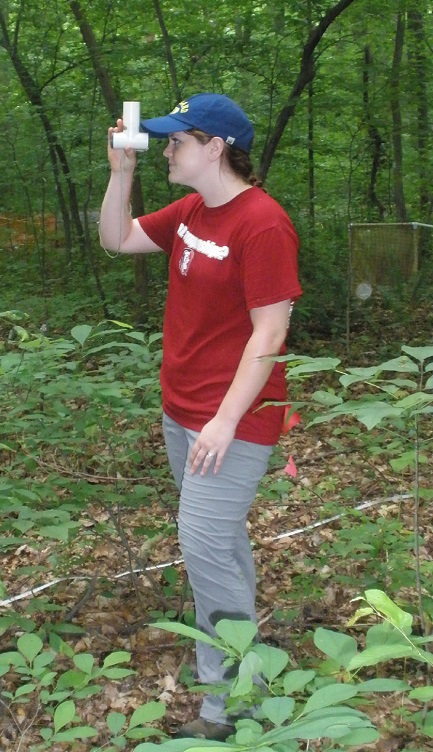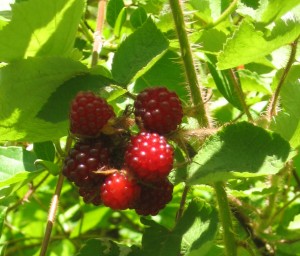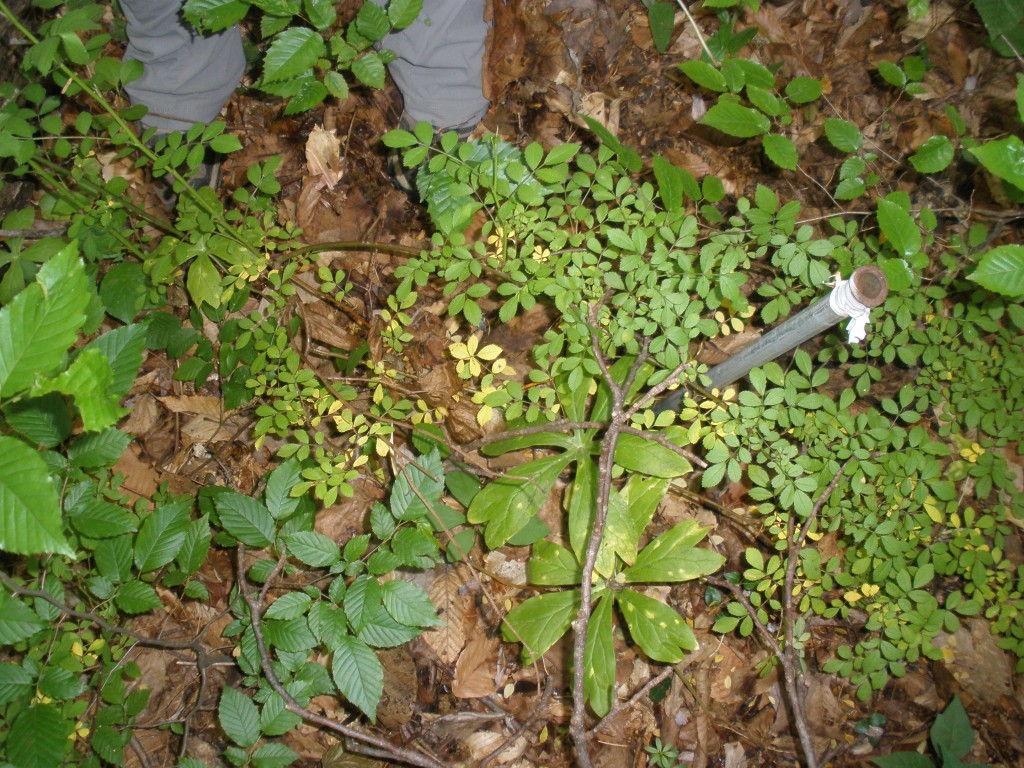By Sarah Hansen

An upland forest plot at SERC. Lauren Emsweller, David Gorchov, and Julia Mudd (left to right) search for five invasive plant species.
Invasive plants are rampant throughout the United States. Some have been here for tens or even hundreds of years, while others are relative newcomers. They compete with native plants for resources, and more often than not they win the fight.
David Gorchov, visiting scientist from Miami University of Ohio, is leading a project to map five invasive plant species in upland forests at the Smithsonian Environmental Research Center (SERC). In particular, he’s interested in how gaps in the forest canopy, usually created by a tree falling, affect the abundance of these invasives. One of his graduate students, Lauren Emsweller, is here working on the project for her master’s thesis. Julia Mudd, a SERC intern from Florida State University, is getting college credit to help them out.
“There are a few studies that have looked at the importance of gaps, but there’s none that have done complete maps like this that I’m aware of,” said Gorchov.
They’re searching for Japanese honeysuckle, Japanese barberry, multiflora rose, Japanese stiltgrass and wineberry. All five are native to east Asia. Stiltgrass came accidentally as a packing material. The others arrived intentionally for various reasons. Wineberry was crossbred with raspberries to create new varieties. Multiflora rose served as a buffer to prevent cropland runoff from entering waterways. “And they’re pretty,” said Mudd.
After Gorchov heads back to Ohio, Emsweller, Mudd, and a newly arrived intern named Eva Kinnebrew will spend the summer mapping the locations of all individuals of these five species in almost nine square hectares of upland forest on SERC property. They’re examining about 800 plots of 10×10 meters each. Each plot has 25 subplots of 2×2 meters. That’s about 20,000 subplots, each of which they must carefully check for the invaders.
After two hours at the field site one muggy June morning, they spotted all of the target species except stiltgrass. “That’s the newest invader, and we are really interested in where it might be,” said Gorchov. “If it’s in a plot, we need to find it.”

Julia Mudd uses a periscope-like “densitometer” to make sure she’s looking straight up when determining the canopy’s density.
The first census of these plants at the SERC site was in 2011 (4 hectares) and 2012 (5 hectares). “So I’m doing the whole thing,” said Emsweller. It’s important to collect data at multiple time points because the plants are long-lived and very hard to age after a certain point. Only by finding seedlings new since 2012 will the team learn where these species initially establish.
Emsweller suspects that seedlings will be more common in gap areas. She also predicts that plants producing fruits will appear more often in gaps. Why? When a tree falls, its branches and leaves no longer block sunlight from reaching the forest floor, and more light makes it easier for baby plants to survive. There are exceptions, though. Gorchov pointed out that in a previous study, wineberry seedlings appeared only in gaps, but established plants were found in gaps and non-gaps. The implication is that once a wineberry plant is established, it has a better chance of riding out challenging conditions.
To find the plants, Gorchov, Emsweller and Mudd lay down tape measures and use small red flags to mark the subplots in each 10×10 meter plot. “It’s the set-up that takes the longest,” said Mudd. Once the flags and tapes are placed, the researchers spout a flurry of what sounds like a secret code and take turns recording data on clipboards, which Emsweller will analyze over the winter. Statements like “All of one is two,” “Multi-stem with two inflorescences in four-one,” and “Prostrate in two-three,” fly across the plot.
If Emsweller is right that these plants pop up in gaps, “it will be a helpful tip to land managers,” she said. They can streamline invasive control efforts by focusing on gap areas and prevent, or at least delay, a nonnative takeover. She’ll also have a great data set for her master’s thesis.
Gorchov is happy to have the opportunity to work at this site because it is in a well-studied forest on protected land. He did a full-year sabbatical at SERC in 2004-2005, and that connection led him back here for additional research beginning in 2011. The current study sits within SERC’s 16-hectare forest dynamics plot, part of the worldwide ForestGEO network coordinated by the Smithsonian Tropical Research Institute to track forest growth around the globe.
Mudd will graduate from FSU in December. She wants to go to graduate school, but isn’t sure what area she’ll pursue. When asked if working in the field is what she expected, she answered, “I’m not so sure what I expected. But I enjoy it!”




I think the canopy helps with the invasive plants. They block the sun and this allows for an easier intrusion.